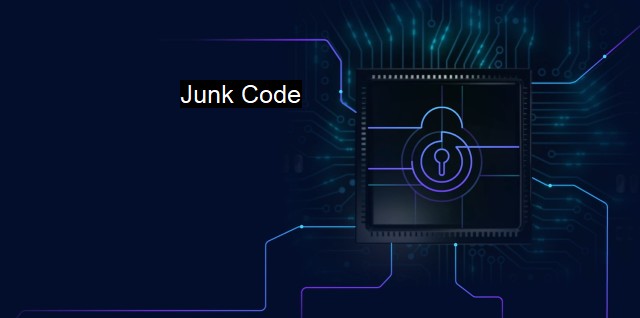What is Junk Code?
The Impact of Junk Code in Cybersecurity: Obfuscating Main Functionality of Applications and Pending Hurdles for Effective Anti-Virus Software Detection
Junk code refers to the padding sections of a computer program, or lines of code that look like normal functional code but in real practical application, does not offer any significant functions or operations. Although the term "junk" implies something useless or of no value, junk code plays a critical role in cybersecurity.The primary objective of junk code is to complicate and obfuscate the real code of a program. It might involve adding unnecessary statements to a program or subtly changing the code's structure to hide its actual operations. By adding or modifying portions of code, developers can shield valuable or critical portions of the program. Common techniques may involve changing variable names, altering loop structures, implementing function calls and return statements multiple times and across different spots of a code, or other similar actions that lead to confusion.
There is a consistent tug and pull between malware authors and antivirus companies. As antivirus software becomes more sophisticated, malware authors continue to increase their efforts to stay undeceptive. This is where junk code comes into play. To deter immediate detection, malware authors imbue their malicious models with junk code, resulting in the antivirus software having a hard time recognizing the hostile software.
Antivirus software utilizes a method known as signature-based detection to identify malware agents. This technique involves scanning incoming code or software for signatures - distinctive characteristics unique to specific malware. extensive use of junk code complicates things for antivirus software. It finds it challenging to match the skewed code with distinctive malware signatures due to the considerable chaos introduced.
One might innocently presume that eliminating every section of a code that appears to serve no tangible purpose may solve the problem. This cannot be farther from the truth. When rid of all junk code, the concealed crucial elements of the original code are left bare, rendering the program utterly frail against malicious threats.
Such protections derived from junk code have accounted to be very effective in some cases. When malware authors combine junk code with packing, a technique that fuurther obfuscates the code with custom data compression and cryptographing algorithms, it becomes even trickier to scan and analyze these threats effectively, thereby remaining successful employing junk code obfuscation.
At the other end of the spectrum, antivirus companies and reverse engineers understand their opponent's subtleties. Modern-day cybersecurity has seen the development of several different techniques proven useful in fighting junk code strategy - static code analysis, dynamic code analysis, and heuristic analysis. This warfare, where malware authors try to outsmart antivirus software and vice versa, leads to continuous advancements in malware and antivirus techniques.
Static code analysis involves analyzing the source code without executing it. It searches for patterns that illustrate paths in the code that execute no operations. The approach taken by dynamic code examines the source code as it runs, making the detecting process faster and eliminating false positives. Lastly, heuristic analysis involves identifying unusual or suspicious behavior across programs.
Despite the seemingly benign connotation carried by the term, junk code serves as a strategic tool in cybersecurity. The deliberate use of misleading junk code is a constant reminder that ongoing learning and adaptation must be driving the cybersecurity strategy reducing the risks in this rapidly shifting environment. For antivirus software developers the challenge lies not only in detecting and eliminating malware but also developing techniques to intelligently sidestep junk code and ensure robust cyber defense mechanism. Cybersecurity is more than a battle of defenses, it is a vibrant competition involving continuous advancements in algorithm sophistication, demonstrating how junk code continues to lay relevance in this age of cyber warfare.

Junk Code FAQs
What is junk code in cybersecurity and antivius context?
Junk code is a type of code that serves no useful purpose in a program, but is added to the program to confuse or evade detection by antivirus software.How does junk code affect antivirus software?
Junk code can make it difficult for antivirus software to distinguish between harmless and malicious code, which can result in both false positives and false negatives.What are some common techniques used to implement junk code?
Some common techniques used to implement junk code include adding redundant instructions, inserting meaningless variables or functions, and obfuscating code with random data.How can developers avoid using junk code in their applications?
Developers can avoid using junk code in their applications by writing clean and efficient code, adhering to coding standards, minimizing the use of obfuscation techniques, and conducting regular code reviews to identify and remove unnecessary code.| | A | | | B | | | C | | | D | | | E | | | F | | | G | | | H | | | I | | | J | | | K | | | L | | | M | |
| | N | | | O | | | P | | | Q | | | R | | | S | | | T | | | U | | | V | | | W | | | X | | | Y | | | Z | |
| | 1 | | | 2 | | | 3 | | | 4 | | | 7 | | | 8 | | |||||||